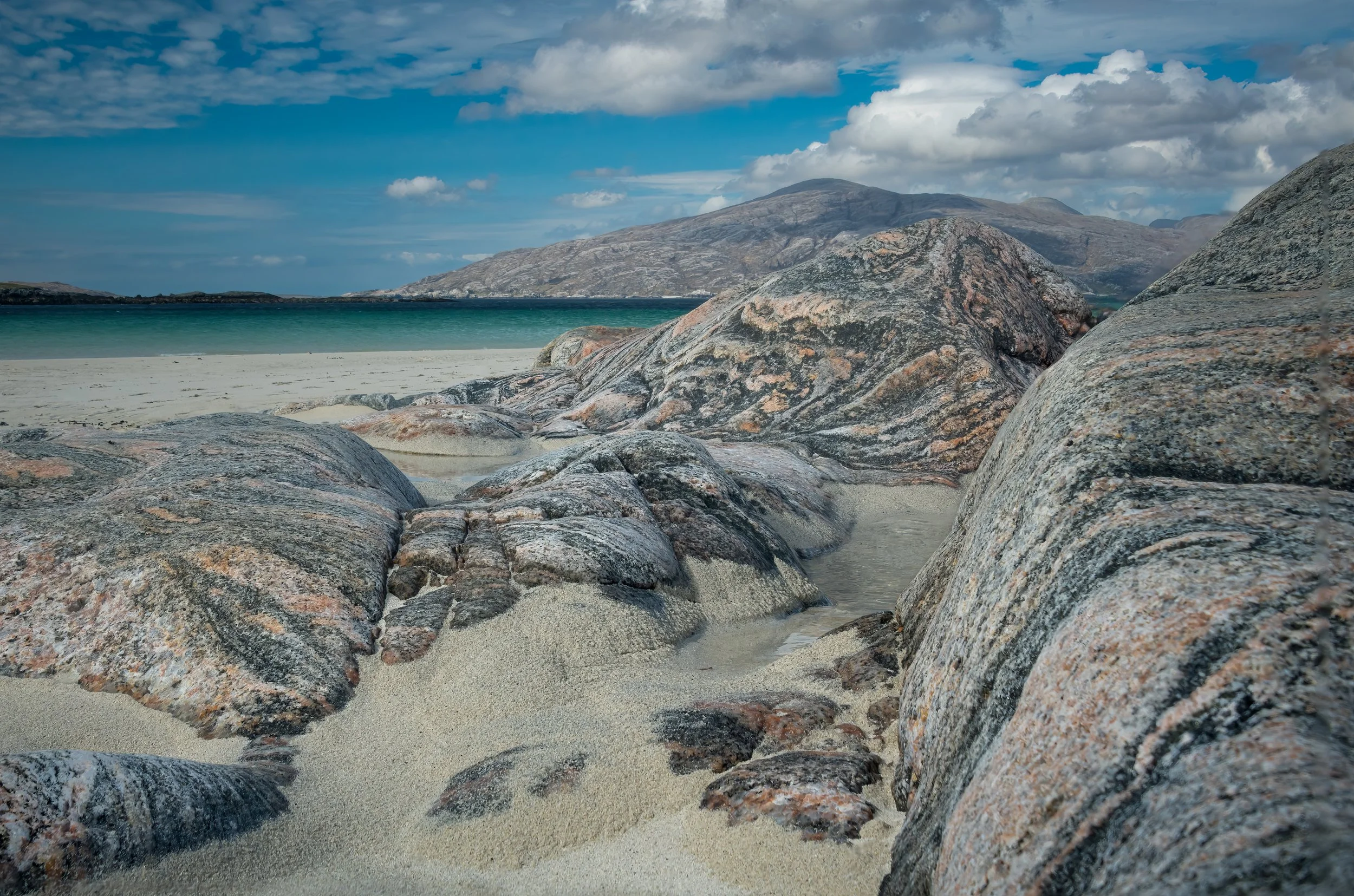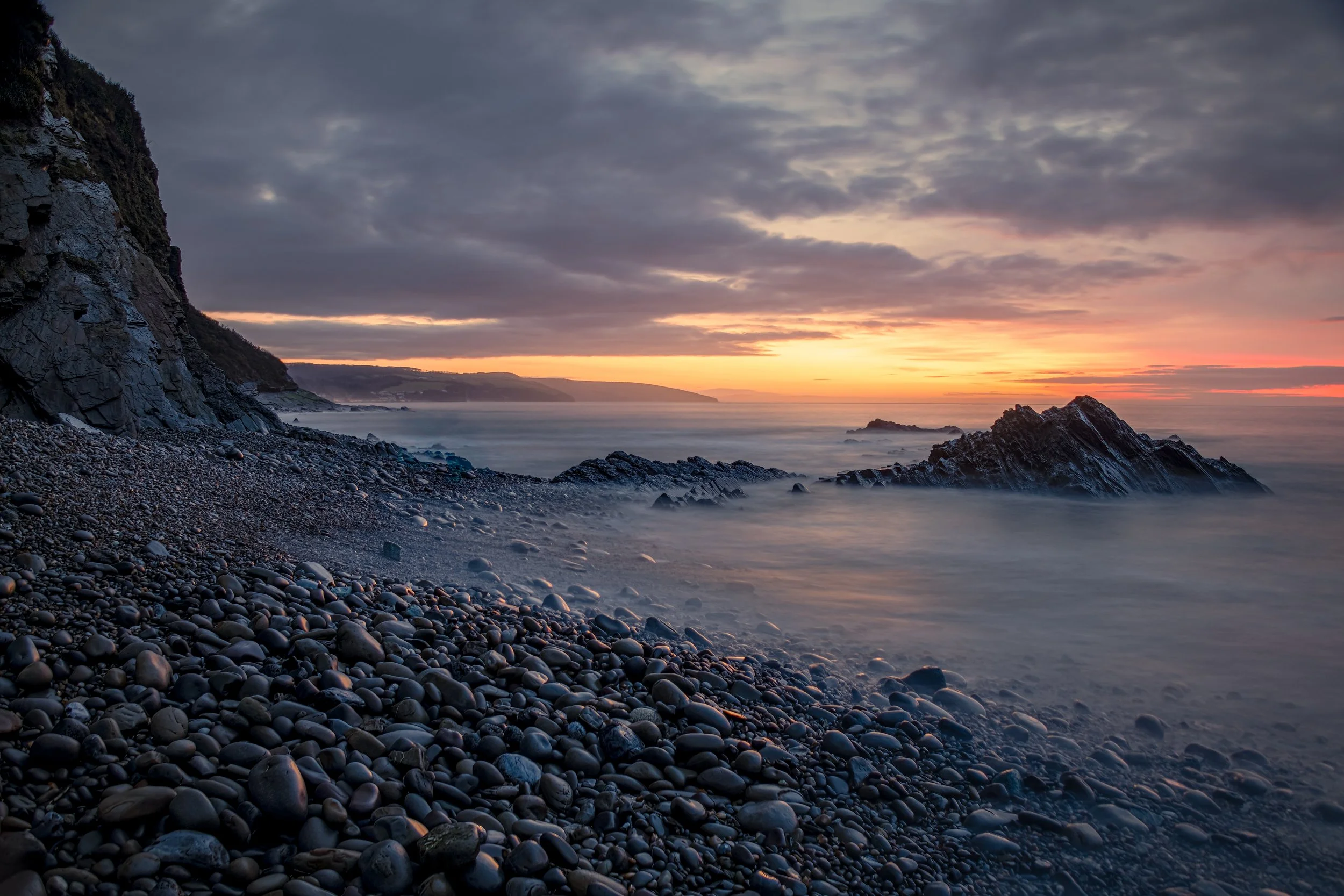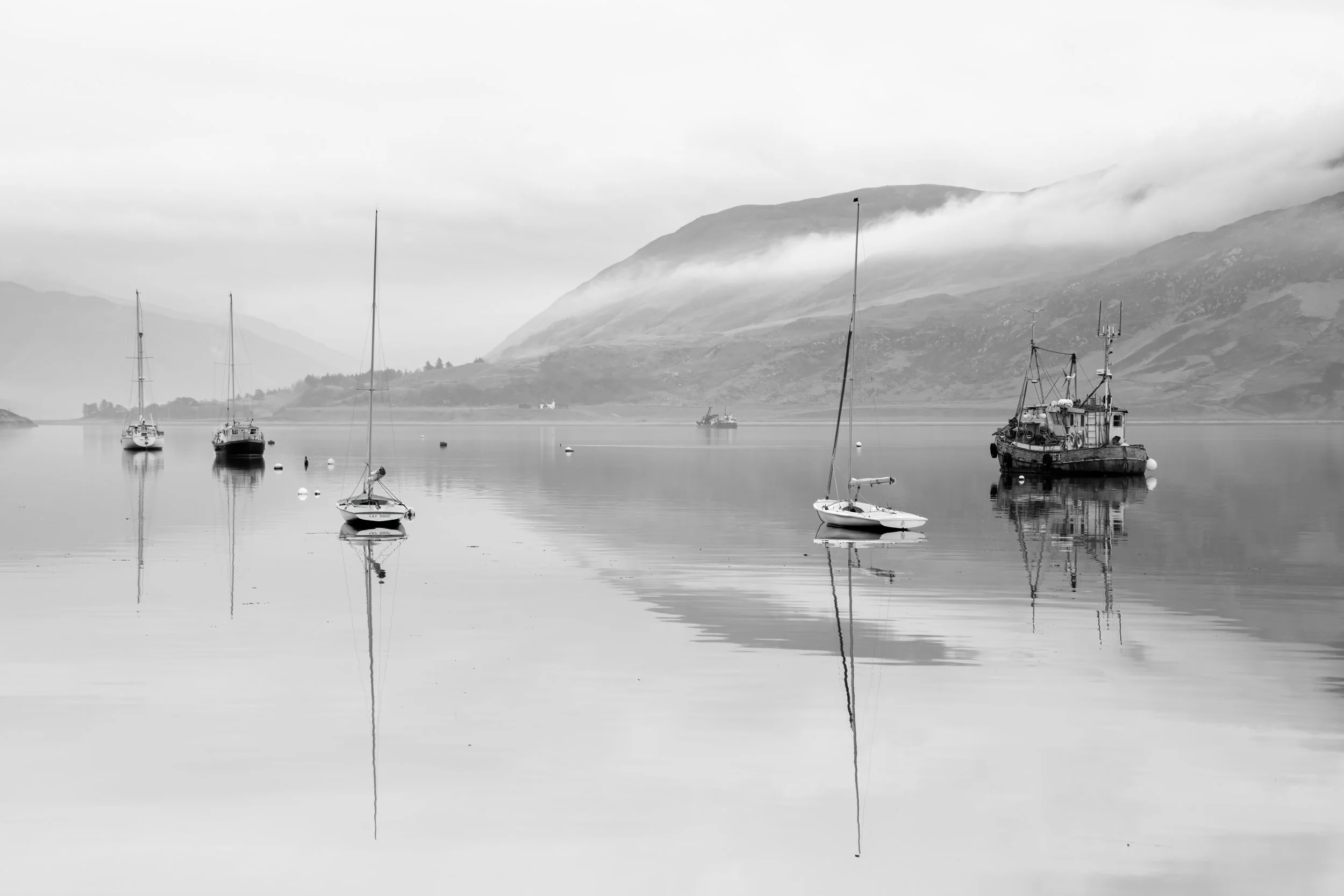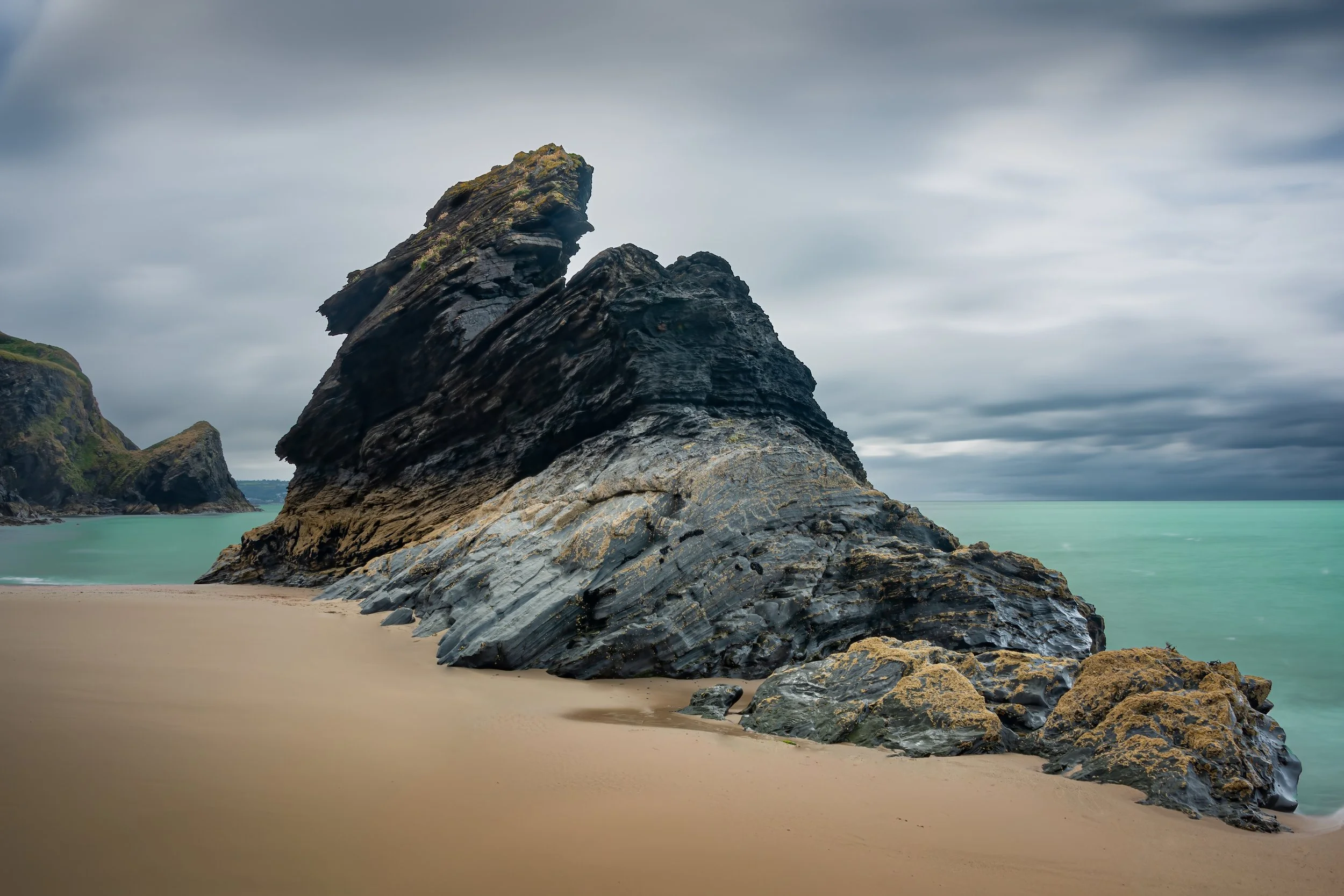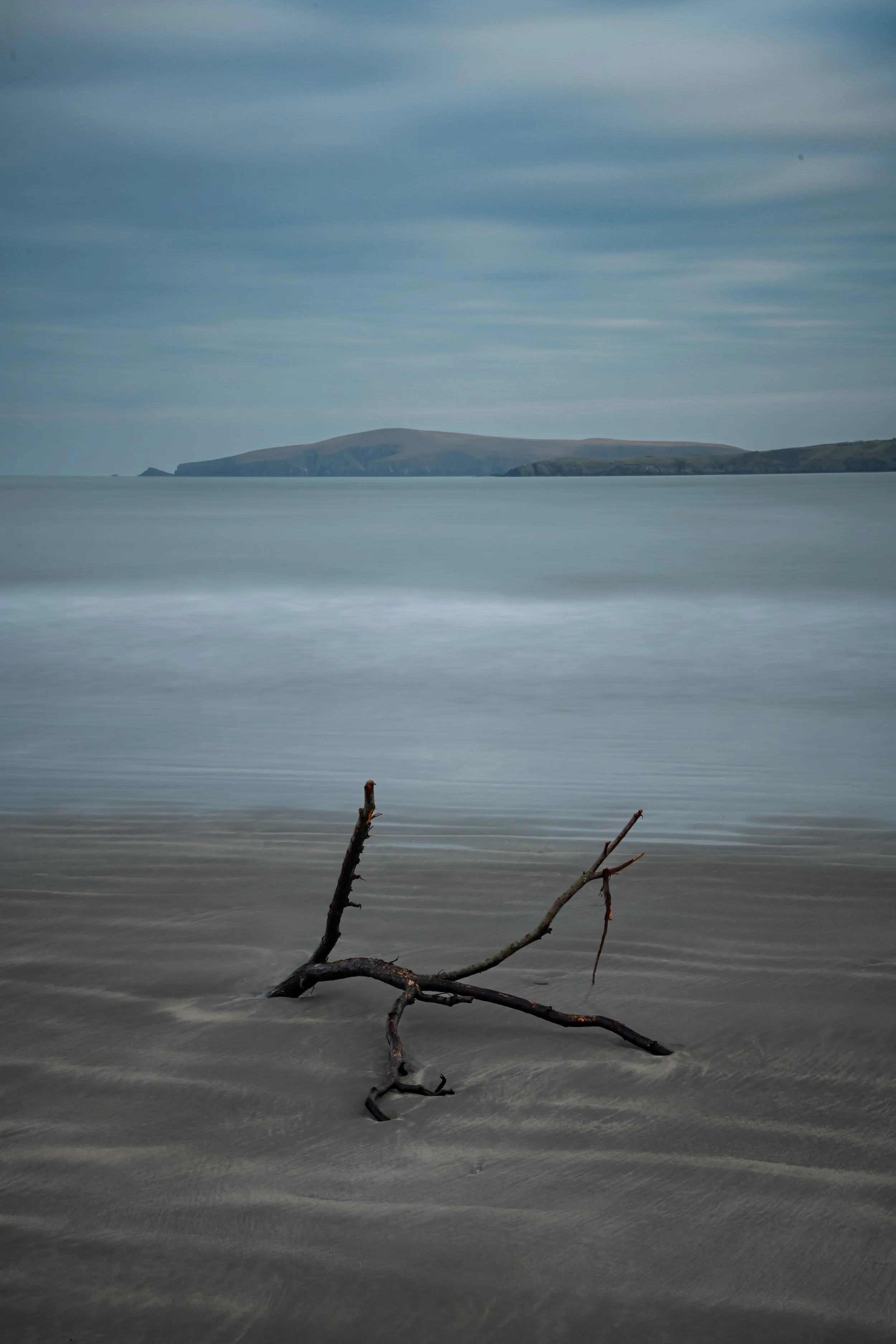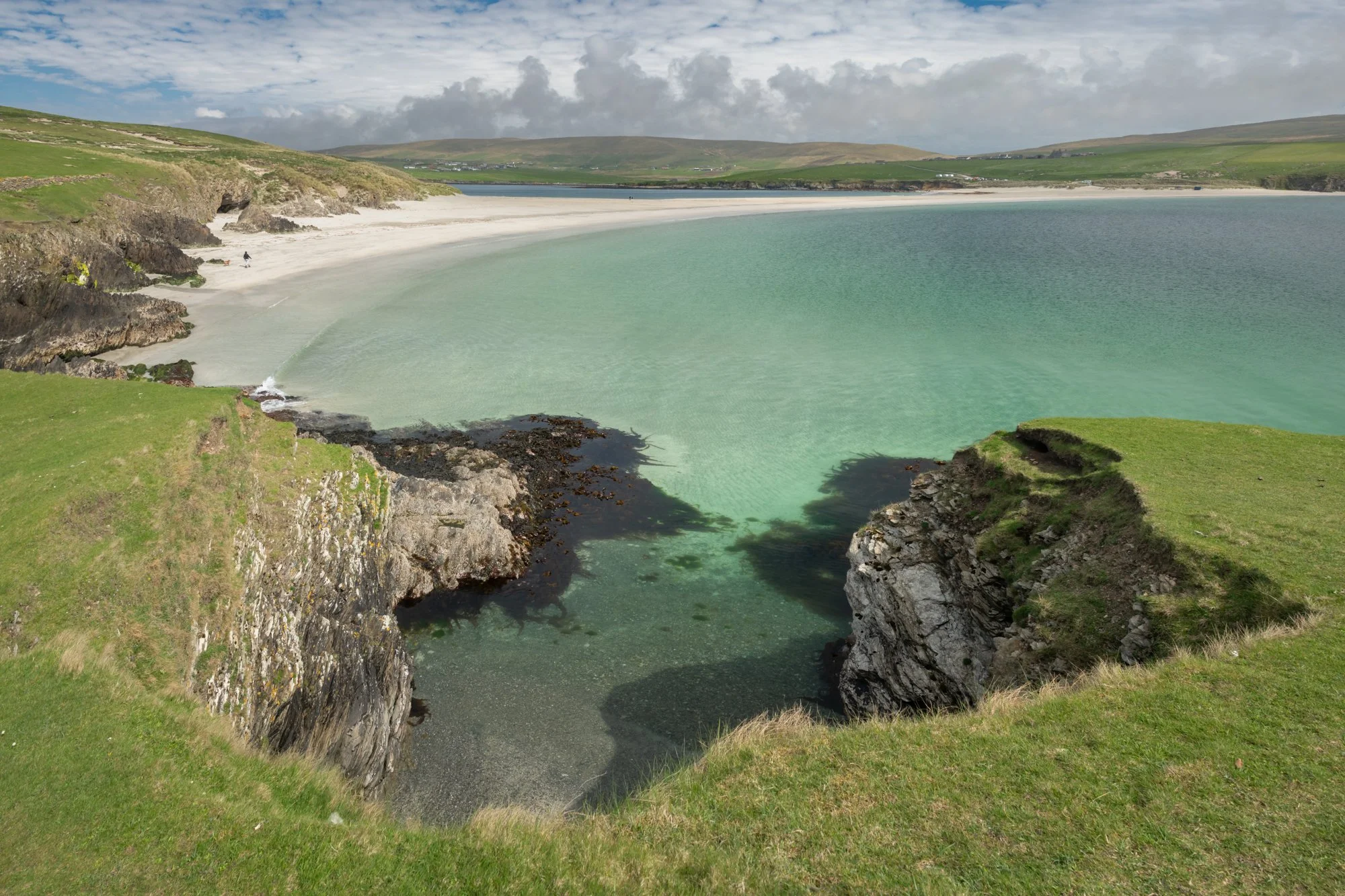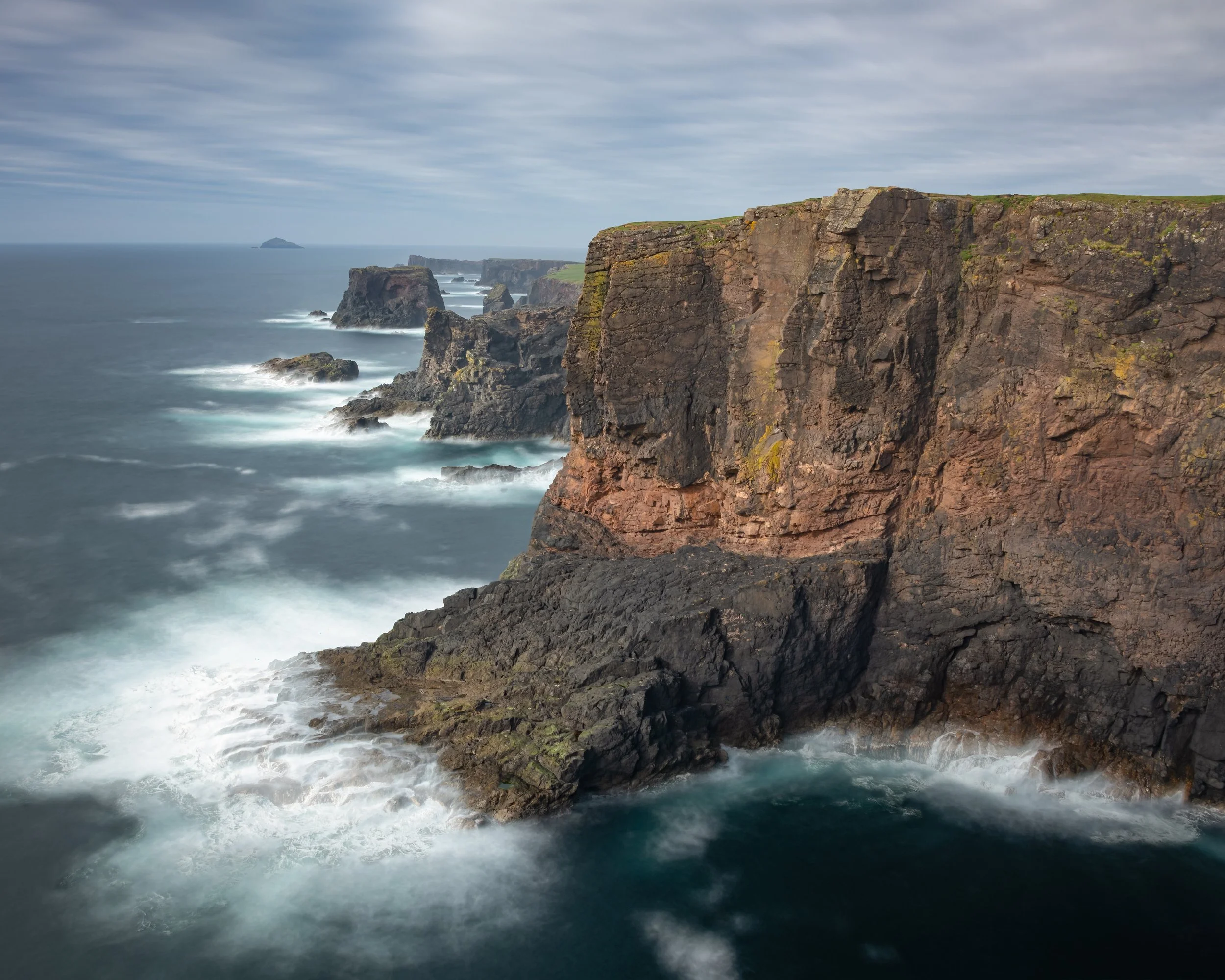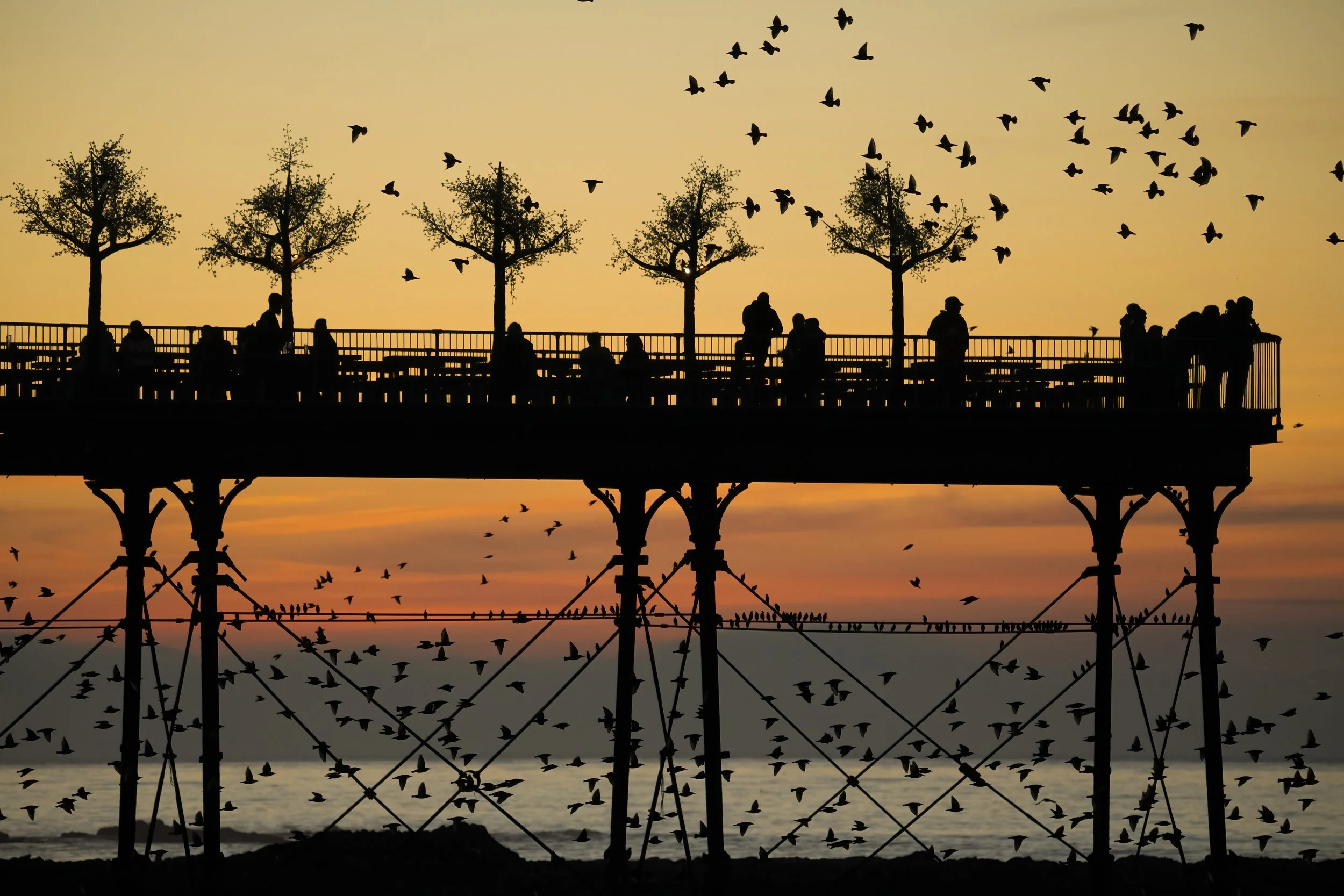“The ocean is everything I want to be”
SEA AND THE COAST
Walking round the coast of the Isle of Lewis from the beach at Shawbost, a beach with so many opportunities to see the rich variety of birdlife on the island, to the natural arch Stac a’ Phris, a walk of just over a mile, seemed so much more when I made the trip in 2024; a bout of Covid had left me very weak. However, I soon forgot my poor condition, as the whole coastline was incredible with cliffs and rock formations, inlets and waves battering the wild West-facing coastline; the rocks themselves boasted a wide variety of colours and textures. In photographing the arch, I wanted to include these varied elements in a balanced whole. Hence an exposure long enough to give the waves a sense of motion, and make visible too the water rushing over the rocks as the waves receded. The foreground features details of shape and colour in the rocks, as well as showing the enclosed sea in front of the arch itself. In the edit I slightly brightened the rock in the middle of this, to help with the structural cohesion of the image, and slightly darkened the sky, a common device to ensure a dynamic range which allows for full detail in both the darks and the lights in the image.
On noticing from the forecast that a very strong onshore wind was on its way later in the day, and checking its exact direction, and tide times, I headed off to the local beach I thought would yield the most spectacular waves, Mwnt in Ceredigion. I was not disappointed. Huge waves were crashing onto the beach and out in the bay, whose effect was exaggerated by the phenomenon of the waves which had just crashed against the cliffs rebounding and hitting the next waves: the result was a massive swell with the foam of the waves atop. I could see straight away that the photo I wanted needed to be in black and white: the drama was in the dramatic lighting contrasts and the sense of motion. I also wanted to frame the waves with a background of the bay, with the cliffs in the background as they faded away in the direction of Cardigan Island. I took many photos and later sifted through five or six I was very happy with; I’ve selected this one for the website, as I think it shows the power of the water and the opposing forces of the currents, as well as an ideal (I hope) positioning of the main wave to the cliffs, and overall sense of balance in the image. The shutter speed needed to be extremely fast in order to “freeze” the motion of the wave.
Another of my local haunts is the peninsula called Ynys Lochtyn, near Llangrannog in Ceredigion. This image does not show the whole peninsula, but features the long curve of the cliff’s edge between two of its “fingers”. I loved the lichen growing only on the edge, emphasising this broad sweep - the eye follows it round all the way to the dark contours of the cliff, where it can also be seen on the outcrops which hit the light. The day was extremely windy, and this was a three-image panorama. I used my tripod, but had to watch my footing on the edge as well as being super-careful not to leave go of the tripod for a single instant, as I didn’t want it to disappear with the camera over the edge and into the sea! An exhilirating challenge which I won’t forget and in a place with very special associations for me. A final detail for the shot as a whole was the decision to keep the image as a whole fairly dark, and in particular to make the cliff dark, even if this meant losing some of its detail .
The beach of Traigh Mheilein, a mile or so from Huisinis in North Harris, shares all the wonderful light sand, turquoise sea and gorgeous hilly backgrounds across the water which the other more well-known beaches such as Losgaintir (Luskentyre) have in abundance and feature in any collection of photos from the Isle of Harris: but I think this would probably be my favourite, if I ever had to do such an unlikely thing as choose one above the others…
With so much photographic material available, I was spoiled for choice when creating an image which encapsulated this location; in the end though it wasn’t hard to choose the Lewisian Gneiss, with its alluring shapes and bands of colour - Lewisian Gneiss is the oldest rock in the whole of Britain. I found a place where some of the formations were particularly attractive and where a collection of rocks made for a satisfying whole, and where I could place them in the context of the beach itself, with the sand a strong element, the sea’s edge with its turquoise colours for which Harris and Lewis are known, and the gentle hills over the water on the island of Scarp.
West Wales has some of the most wonderful coastal scenery in the world! I therefore jumped at the suggestion by my friend and fellow-photographer Nigel Thomas to accompany him to Wiseman’s Bridge in South Pembrokeshire, somewhere I hadn’t been before. I couldn’t use early morning laziness to abort the trip at the last minute, as I’d made the commitment with Nigel (he later said he’d had exactly the same thought!) I drove my van to the vicinity the night before. The day in question was chosen because of the high tide around sunrise, and we were rewarded with lovely orange skies and interesting cloud formations. The rocks sticking out of the sea were an obvious subject, but I was also transfixed by the large round stones on the beach, and how the receding waves poured over these stones and in the gaps between them. So they had to be a strong feature of the photo, especially as the sunrise glow illuminated them, giving them pink highlights. For me this had to be a long exposure, making visible the softly receding water, and giving an ethereal quality to the image as a whole. I also placed myself so that the main rock in the sea was balanced against the cliff on the other side, and the foreground stones leading through the picture along the coast. I felt I’d done the place justice!
I was booked for a week on the island of Skokholm off the West coast of Pembrokeshire, mostly for the purpose of enjoying the bird life, seals and other wildlife; puffins and razorbills are star players here. Skokholm is given over to conservation, and it is not possible to go there on a day trip, so being there with just ten other visitors plus a few staff, and having the island to ourselves for the whole week, was a real privilege. Elsewhere on the site there are photos of some of the wildlife, but I include this image of a part of the coastline called Quarry Point, where there were fascinating jagged rock formations, all leaning in one direction; these rocks were ablaze with colour - reds, yellows and greens. With the waves crashing over as a couterpoint to them I saw the opportunity for a more abstract kind of photo, using a long exposure, but not so long as to lose detail in the waves, but to emphasise their motion. I can’t stop looking at this image, although I may be prejudiced because of my memories of this South West portion of the island, where a lighthouse stands nearby and the Manx Shearwaters came on shore in their thousands at night and we were able to witness this.
I’ll say straight off that this image needs to be looked at on a large screen (well, like all the other pictures too, but in this case particularly so): thousands of gannets sit on the rocks, which otherwise just look like small specks. You are looking at the most northerly place in the British Isles: Hermaness, on the island of Unst, the most northerly island in the Shetland archipelago. I visited Shetland in May 2025 and a trip to Hermaness was a top priority. The scenery was extremely dramatic and knowing that looking North there is nothing but ocean until you reach the pole was very affecting. I have chosen an image which features the gannets, which were the main bird species present when I visited, the broken promontaries, the natural arch and the precipitous coastline. I took a panorama of about four separate overlapping images which I stitched together with editing software. I was attracted here also by the strong contrasting colours, and the various separate large groups of gannets: zoom in and there is also a lot of detail on the birds themselves!
On my visit to the North West Highlands in 2023 I passed through the pretty little town of Ullapool, where I would later take the ferry over to Tarbert on the isle of Harris. I had been encountering some very “Scottish” weather, but the dense mist and driving rain began to clear, and looking out from the harbour at the little boats moored on Loch Broom, and with the hills behind still partially veiled in mist, I had the idea of a slightly “high-key” photo in black and white (but mostly white) which would reflect the feeling of calm and peace after the storm. It remained to compose a balanced image, using not only the boats, but their masts and reflections. I hope I have achieved this at least in part.
In mythology, this rock, Carreg Bica, is the tooth of the giant Bica. Its familiar profile is from the other side of the beach, where it has a more vertical characteristic. But I’d challenged myself to find aspects that I had not brought out previously, and looking from this point I thought the rock ressembled a resting giant looking over its shoulder. I wanted quite a stark and simple image which nonetheless included the other familiar features of Llangrannog beach, where the rock is located. A long exposure “smoothed out” the sea, which in the context I felt would have distracted from the main theme. In keeping with this I also wanted to keep the sand featureless, so I needed to do some discrete editing to get rid of some footprints. I slightly darkened the sky to emphasise its brooding quality.
A late evening shot taken near the Green Bridge of Wales in South Pembrokeshire. I had been exploring this whole section of coastline during the day, and stayed till later to see whether there might be a good sunset image. After this I felt I had had a most rewarding and productive day, and was finally packing away when I looked up and saw the moon coming up, veiled in a slight haze. I realized that it was in exactly the right place for a shot looking Eastwards. I got the camera out again: I needed two images, as the one of the land and sea needed to be a long exposure because it was nearly dark, but the moon itself would have been overblown and too light on the same exposure setting. I blended the sky part with the rest of the image in software, and I hope that the composition is effective, and I certainly feel that some of the magic of the scene is conveyed. Part of the art of photography is always to remain alert and aware when unexpected or changed conditions present something very different to the original intention!
A second image here of Ynys Lochtyn on the Ceredigion coast. There was a fair amount of acrobatics required to get myself onto the rocky outcrop from where I took the image. In addition, my decision to include the whole headland, the foreground rocks and coastline, meant I needed to have a very wide angle shot, and my lenses I had on me were not wide enough. I therefore took nine photos, in both a normal panorama, but also a vertical “panorama”. Each image also used a technique called exposure bracketing, which is used in cases where the dynamic range in the image is too great to be caught by a single image, and so three (for example) are taken - a normal one, a brighter one and a darker one - which are blended in post-production. I was therefore very glad that the final result has turned out as I’d hoped: taking 27 separate images, each one a 30-second exposure, and all perched precariously on a rock jutting out high above the sea….
I have often been drawn to Poppit Sands, where the river Teifi emerges into Cardigan Bay. On a windy day, light-coloured loose sands blow over the darker heavier sands underneath and often produce fantastical patterns. The view from the beach of Gwbert opposite and Cardigan Island are also features of Poppit. A local group promoting a footpath in the area had asked whether I had any photos of Poppit for their publicity material. I wasn’t sure whether what I had was suitable so told them I would go down and make some new images which they could use if they wanted to. I had a very nice few hours on the beach and was pleased at some of the images, but never heard back from the group so I think they must have wanted something different! My favourite is the above - I think it shows the sense of calm and space as well as the unique textures of the sand, and the tell-tale profile of Cardigan Island in the background gives a sense of form to the image. The driftwood, a typical feature of Poppit, features and in my opinion makes the image.
Borve, in South Harris: a shot with familiar elements which tries to get a sense of this extraordinary coastline. The gentle contours of the foreground hill and the beach (whose shapes mirror each other), the turquoise sea and the mountains of North Harris in the background; the blue sky complementing the colour of the sea, and the dappled clouds. There is a wonderful light so typical of the West coast of Harris, which makes the image almost hypnotic to look at. I’ve used a wider than normal aspect ratio which I hope suits the subject matter.
St. Ninian’s Island on Shetland, with the famous “tombolo” as seen in the TV series “Shetland”. Before coming to Shetland in May 2025 I had never heard the word “tombolo” (with an o). But in Shetland these double beaches were quite common, and this one, the largest anywhere in the UK, joined the mainland to St. Ninian’s island. The favoured view of this is a drone photo from above, which does indeed create a magical effect. But I loved the view from a little way off on the island, with the little beach and inlet providing the foreground, and featuring the very long curved sweep of the tombolo. There is enough of a slither of sea beyond to identify the beach as a tombolo, and the overall form of the image is satisfying.
I was lucky here that so many things co-incided here to make a dramatic image looking down the coast from Llangrannog, Ceredigion. The landmark triangular hill at Mwnt can be seen here on the horizon between the two waves. I was at the beach working out possible sunset images for later, but this combination of stormy conditions - the haze from the late afternoon sunset bathing all in its light, the extremely agitated sea and the presence of so many gulls near the water; the tide… - all of these gave a perfect opportunity for a shot. I shot a quick burst of images so I could choose the one with the ideal waves for the final photo.
Travelling in Shetland during May 2025 I noticed on my OS map a very small road leading to a lighthouse which piqued my curiosity; it was called Eshaness. I wasn’t sure what I would find there as I usually prefer not to do a lot of research in advance of visiting a new place, as I like the sense of discovery, and, importantly, don’t want to fill my mind with everyone else’s images, prefering the chance to have my own fresh response. So, on getting out of the van in a very high wind and a bright but stormy sky, I was totally amazed with this view which I had not at all expected. I knew that the ideal time for a photo was right then, so I got out my equipment without delay. I told myself that great care was needed here, as I was near the edge of the cliff, it was windy, and I was feeling distracted by the wonderful view. I wanted to position myself so that the foreground cliff could showcase the rock formations and colours (but still have the water in front of it at the base of the image), and have the other cliffs disappearing layer on layer into the distance. It was such a large scale, I wanted to convey this in the photo. I had to wait for the right moment for the sun to be shining on the right parts of the image, and then took some long-exposure shots (like this one) and some very short exposures which showed the waves frozen in time. I thought that this long exposure shot was right for this scene, as it somehow emphasises the grandeur and scale of the scene, but in the end I wasn’t sure. I also didn’t photograph the lighthouse itself!
Here in Ceredigion, the starling murmurations are famous, especially the one at Aberystwyth pier. In the winter many people gather to watch the hundreds of thousands of birds arrive as the sun disappears below the horizon. It’s fortunate that the sun sets immediately behind the pier, so looking at the orange sky behind the silhouette of the pier and grid of supports makes for a great image. I waited until some starlings had already perched on the horizontals whilsts others were still in the air, as people sat at their tables on the pier above. This is a picture which pretty much takes itself, but it needs a longish lens and a fast exposure in the dying light, so settings have to be spot-on and a tripod necessary.
Another photo of Llangrannog. An image like this has to be planned, as the sun needs to be in a certain place when going down, and the tide has to be in a precise place too. Here we see the water beginning to surround Carreg Bica (featured in another photo above) but the sand is visible in the foreground, with a texture I wanted which had the evening golden glow, emphasised by its being wet from a wave that had just receded. I loved the cloud patterns that evening. The edge of the village and some boats are visible, but more important to me is the disposition of the various rocks and cliffs. I intended to give a slightly mysterious and magical quality to the image.



